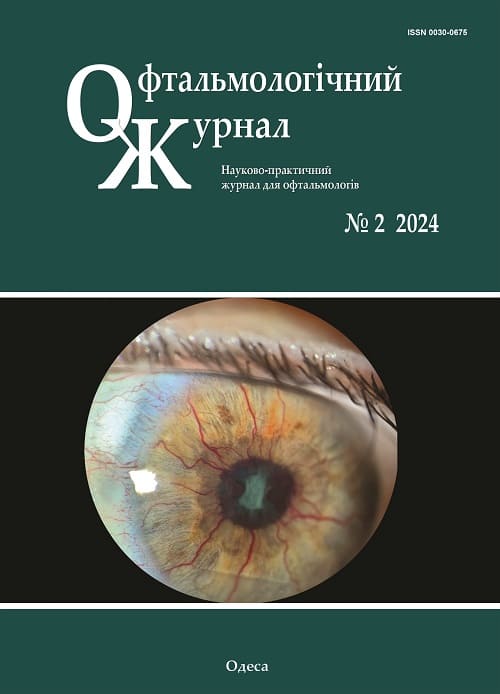Use of bromfenac 0.09% (Broksinak) in the complex therapy for HLA-B27-associated anterior uveitis
DOI:
https://doi.org/10.31288/oftalmolzh202421924Keywords:
HLA-B27-associated anterior uveitis, uveitis, corticosteroids, bromfenac, dexamethasone, glaucomaAbstract
Background: There is still no consensus among ophthalmologists as to whether the prolonged use of topical bromfenac 0.09% is feasible in therapy for acute uveitis.
Purpose: To improve the efficacy of treatment of HLA-B27-associated anterior uveitis through the use of Broksinak (containing bromfenac 0.09%) as an addditional therapy to the complex treatment regimen.
Material and Methods: This study involved 42 patients (72 eyes) with a diagnosis of HLA-B27-associated anterior uveitis. Follow-up duration was 24 months. All patients were administered systemic methylprednisolone and methotrexate. Patients of the bromfenac group were administered Broksinak eye drops (containing bromfenac 0.09%) as an additional treatment to primary systemic therapy over the course of the follow-up. Patients of the control group were administered dexamethasone 0.1% eye drops.
Results: There was no significant difference between the groups in terms of the number of recurrent uveitis episodes (р = 0.85) and laser flare reading during recurrent episodes (р = 0.56). In most recurrent uveitis episodes, laser flare readings were within the range of 20 to 50 ph/ms. There was a significant difference between the groups in the number of eyes that developed complications such as cataract (р = 0.05) and elevated intraocular pressure (р = 0.07). Cataract developed in 8 eyes of the bromfenac group and 19 eyes of the control group. At the final follow-up, elevated IOP was seen in 1 patient (1 eye) in the former group and 6 patients (7 eyes) in the latter group. At baseline, mean visual acuity (standard deviation (SD)) was 0.86 (0.21) for the bromfenac group and 0.78 (0.18) for the control group (p = 0.07). At the final follow-up, mean visual acuity (SD) was 0.86 (0.21) for the former group and 0.78 (0.18) for the latter group, ath the difference was significant (p = 0.006). No side effects from bromfenac 0.09% were noted in patients of the bromfenac group over the course of the study.
Conclusion: The use of Broksinak containing bromfenac 0.09% as an additional therapy to complex treatment regimens improves the efficacy of treatment of HLA-B27-associated anterior uveitis. With the prolonged use of Broksinak, the bromfenac group exhibited a reduction in recurrence severity not less than the group treated with dexamethasone eye drops 0.1%. Moreover, the side effects (cataract and elevated IOP) typical for dexamethasone were seen significantly less frequently, and no corneal lesions were detected in the former group.
References
Balasubramaniam B, Chong YJ, Azzopardi M, Logeswaran A, Denniston AK. Topical Anti-Inflammatory Agents for Non-Infectious Uveitis: Current Treatment and Perspectives. J Inflamm Res. 2022; 15: 6439-6451. https://doi.org/10.2147/JIR.S288294
Becker MD, Adamus G, Davey MP, Rosenbaum JT. The role of T cells in autoimmune uveitis. Ocul Immunol Inflamm. 2000;8:93-100. PMID: 10980681. https://doi.org/10.1076/0927-3948(200006)8:2;1-0;FT093
Wakefield D, Chang H John, Amjadi Shahriar, Maconochie Zoe, el-Asrar Ahmed Abu. McCluskey P. What is new HLA-B27 acute anterior uveitis? Ocul Immunol Inflamm. 2011 Apr;19(2):139-44. https://doi.org/10.3109/09273948.2010.542269
Bouzid N, Jamilloux Y, Chapurlat R, Pradat P, De Parisot A, Kodjikian L, Sèves P. Impact of systemic treatments on the course of HLA-B27-associated uveitis: A retrospective study of 101 patients. PLoS One. 2020;15(3): e0230560. https://doi.org/10.1371/journal.pone.0230560
Zborovskaia AV, Dorokhova AE. Biological therapy in treatment of uveitis. Contemporary trends. J Ophthalmol. (Ukraine). 2017;5:60-65. https://doi.org/10.31288/oftalmolzh201756065
Castiblanco С, Foster CS. Review of Systemic Immunosuppression for Autoimmune Uveitis. Ophthalmol Ther. 2014;3(1,2):17-36. https://doi.org/10.1007/s40123-014-0023-x
García-Lagunar MH, Gutiérrez-Cívicos MR, García-Simón MS, Conesa-Zamora P, Jimenez-Santos E, Cano-Vivar P, et al. Reasons for discontinuation and adverse effects of TNFα inhibitors in a cohort of patients with rheumatoid arthritis and ankylosing spondylitis. Ann Pharmacother. 2017;51(5):388-393. https://doi.org/10.1177/1060028016682330
Sampaio-Barros PD, van der Horst-Bruinsma IE. Adverse effects of TNF inhibitors in SpA: are they different from RA? Best Pract Res Clin Rheumatol. 2014 Oct;28(5):747-763. Epub 2014 Oct 31. https://doi.org/10.1016/j.berh.2014.10.001
Taylor SR, Isa H, Joshi L, et al. New developments in corticosteroid therapy for uveitis. Ophthalmologica. 2010;224 Suppl 1:46-53. https://doi.org/10.1159/000318021
Ferreira LB, Farrall AL, Furtado JM, Smith JR. Treatment of noninfectious uveitis. Arq Bras Oftalmol. 2021;84(6):610-21. doi.org/10.5935/0004-2749.20220094
Fujishima H. Pharmacology, clinical efficacy and safety of bromfenac ophthalmic solution. Expert Rev Ophthalmol. 2007;2(4):543-549. https://doi.org/10.1586/17469899.2.4.543
Tallouzi MO, Moore DJ, Bucknall N, et al. Outcomes important to patients with non-infectious posterior segment-involving uveitis: a qualitative study. BMJ Open Ophthalmol. 2020;5(1):e000481. https://doi.org/10.1136/bmjophth-2020-000481
Airody A, Heath G, Lightman S, Gale R. Non-infectious uveitis: optimising the therapeutic response. Drugs. 2016;76(1):27-39. https://doi.org/10.1007/s40265-015-0502-y
Phulke S, Kaushik S, Kaur S, Pandav SS. Steroid-induced glaucoma: an avoidable irreversible blindness. J Curr Glaucoma Pract. 2017;11(2):67. https://doi.org/10.5005/jp-journals-10028-1226
Raizman M. Corticosteroid therapy of eye disease: fifty years later. Arch Ophthalmol. 1996;114(8):1000-1001. https://doi.org/10.1001/archopht.1996.01100140208016
Pleyer U, Ursell PG, Rama P. Intraocular pressure effects of common topical steroids for post-cataract inflammation: are they all the same? Ophthalmol Ther. 2013;2(2):55-72. https://doi.org/10.1007/s40123-013-0020-5
Blum-Hareuveni T, Seguin-Greenstein S, Kramer M, et al. Risk factors for the development of cataract in children with uveitis. Am J Ophthalmol. 2017;177:139-143. https://doi.org/10.1016/j.ajo.2017.02.023
Thorne JE, Woreta FA, Dunn JP, Jabs DA. Risk of cataract development among children with juvenile idiopathic arthritis-related uveitis treated with topical corticosteroids. Ophthalmology.2010;117(7):1436-1441. https://doi.org/10.1016/j.ophtha.2009.12.003
Petrushkin H, Rogers D, Pavesio C. The use of topical non-steroidal anti-inflammatory drugs for uveitic cystoid macular edema. Ocul Immunol Inflamm. 2018;26(5):795-797. https://doi.org/10.1080/09273948.2016.1269931
Wakai A, Lawrenson JG, Lawrenson AL, Wang Y, Brown MD, Quirke M, et al. Topical non-steroidal anti-inflammatory drugs for analgesia in traumatic corneal abrasions. Cochrane Database Syst Rev. 2017 May 18; 5:CD009781. https://doi.org/10.1002/14651858.CD009781.pub2
Asai T, Nakagami T, Mochizuki M, Hata N, Tsuchiya T, Hotta Y. Three cases of corneal melting after instillation of a new nonsteroidal anti-inflammatory drug. Cornea. 2006;25:224-227. https://doi.org/10.1097/01.ico.0000177835.93130.d4
Isawi H, Dhaliwal DK. Corneal melting and perforation in Stevens Johnson syndrome following topical bromfenac use. J Cataract Refract Surg. 2007;33:1644-1646. https://doi.org/10.1016/j.jcrs.2007.04.041
Seitz B, Sorken K, LaBree LD, Garbus JJ, McDonnell PJ. Corneal sensitivity and burning sensation. Comparing topical ketorolac and diclofenac. Arch Ophthalmol. 1996;114:921-924. https://doi.org/10.1001/archopht.1996.01100140129002
Szerenyi K, Sorken K, Garbus JJ, Lee M, McDonnell PJ. Decrease in normal human corneal sensitivity with topical diclofenac sodium. Am J Ophthalmol. 1994;118:312-315.
https://doi.org/10.1016/S0002-9394(14)72954-X
Yanai K, Huang J, Kazuaki K, Eiichi U. Corneal sensitivity after topical bromfenac sodium eye-drop instillation. Clin Ophthalmol. 2013;7:741-744. https://doi.org/10.2147/OPTH.S41801
Radwan AE, Arcinue CA, Yang P, Artornsombudh P, Abu Al-Fadl EM, Foster CS. Bromfenac alone or with single intravitreal injection of bevacizumab or triamcinolone acetonide for treatment of uveitic macular edema. Graefes Arch Clin Exp Ophthalmol. 2013;251(7):1801-1806. https://doi.org/10.1007/s00417-013-2309-4
Jones J, Francis P. Ophthalmic utility of topical bromfenac, a twice-daily nonsteroidal anti-inflammatory agent. Expert Opin Pharmacother. 2009;10(14):2379-2385. https://doi.org/10.1517/14656560903188425
Bucolo C, Drago F, Maisto R, Romano GL, D'Agata V, Maugeri G, Giunta S. Curcumin prevents high glucose damage in retinal pigment epithelial cells through ERK1/2-mediated activation of the Nrf2/HO-1 pathway. J Cell Physiol. 2019;234:17295-17304. https://doi.org/10.1002/jcp.28347
Downloads
Published
How to Cite
Issue
Section
License
Copyright (c) 2024 Олександра Зборовська

This work is licensed under a Creative Commons Attribution 4.0 International License.
This work is licensed under a Creative Commons Attribution 4.0 International (CC BY 4.0) that allows users to read, download, copy, distribute, print, search, or link to the full texts of the articles, or use them for any other lawful purpose, without asking prior permission from the publisher or the author as long as they cite the source.
COPYRIGHT NOTICE
Authors who publish in this journal agree to the following terms:
- Authors hold copyright immediately after publication of their works and retain publishing rights without any restrictions.
- The copyright commencement date complies the publication date of the issue, where the article is included in.
DEPOSIT POLICY
- Authors are permitted and encouraged to post their work online (e.g., in institutional repositories or on their website) during the editorial process, as it can lead to productive exchanges, as well as earlier and greater citation of published work.
- Authors are able to enter into separate, additional contractual arrangements for the non-exclusive distribution of the journal's published version of the work with an acknowledgement of its initial publication in this journal.
- Post-print (post-refereeing manuscript version) and publisher's PDF-version self-archiving is allowed.
- Archiving the pre-print (pre-refereeing manuscript version) not allowed.












